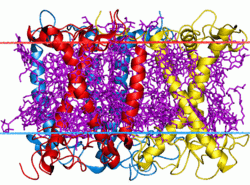- Light-harvesting complexes of green plants
-

Light-Harvesting Complex II Identifiers Symbol Chloroa_b-bind Pfam PF00504 InterPro IPR001344 SCOP 1rwt OPM family 1 OPM protein 1rwt Available protein structures: Pfam structures PDB RCSB PDB; PDBe PDBsum structure summary The light-harvesting (or antenna) complex of plants is an array of protein and chlorophyll molecules embedded in the thylakoid membrane which transfer light energy to one chlorophyll a molecule at the reaction center of a photosystem.
The antenna pigments are predominantly chlorophyll b, xanthophylls, and carotenoids. Chlorophyll a is known as the core pigment. Their absorption spectra are non-overlapping in order to broaden the range of light that can be absorbed in photosynthesis. The carotenoids have another role as an antioxidant to prevent photo-oxidative damage of chlorophyll molecules. Each antenna complex has between 250 and 400 pigment molecules and the energy they absorb is shuttled by resonance energy transfer to a specialized chlorophyll-protein complex known as the reaction center of each photosystem. The reaction center initiates a complex series of chemical reactions that capture energy in the form of chemical bonds.
For photosystem II, when either of the two chlorophyll a molecules at the reaction center absorb energy, an electron is excited and transferred to an electron acceptor molecule, phaeophytin, leaving the chlorophyll a in an oxidized state. The oxidised chlorophyll a replaces the electrons by photolysis that involves the reduction of water molecules to oxygen, protons and electrons.
Under changing light conditions, the reversible phosphorylation of light harvesting chlorophyll a/b binding proteins (LHCII) represents a system for balancing the excitation energy between the two photosystems[1].
The N-terminus of the chlorophyll A-B binding protein extends into the stroma where it is involved with adhesion of granal membranes and photo-regulated by reversible phosphorylation of its threonine residues[2]. Both these processes are believed to mediate the distribution of excitation energy between photosystems I and II.
This family also includes the photosystem II protein PsbS, which plays a role in energy-dependent quenching that increases thermal dissipation of excess absorbed light energy in the photosystem[3].
References
- ^ Liu XD, Shen YG (2004). "NaCl-induced phosphorylation of light harvesting chlorophyll a/b proteins in thylakoid membranes from the halotolerant green alga, Dunaliella salina". FEBS Lett. 569 (1–3): 337–340. doi:10.1016/j.febslet.2004.05.065. PMID 15225658.
- ^ Andersson B, Yang DH, Paulsen H (2000). "The N-terminal domain of the light-harvesting chlorophyll a/b-binding protein complex (LHCII) is essential for its acclimative proteolysis". FEBS Lett. 466 (2–3): 385–388. doi:10.1016/S0014-5793(00)01107-8. PMID 10682866.
- ^ Kramer D, Bassi R, Li XP, Gilmore AM, Caffarri S, Golan T, Niyogi KK (2004). "Regulation of photosynthetic light harvesting involves intrathylakoid lumen pH sensing by the PsbS protein". J. Biol. Chem. 279 (22): 22866–22874. doi:10.1074/jbc.M402461200. PMID 15033974.
See also
Categories:- Protein domains
- Protein families
- Transmembrane proteins
- Plant physiology
- Photosynthesis
Wikimedia Foundation. 2010.
